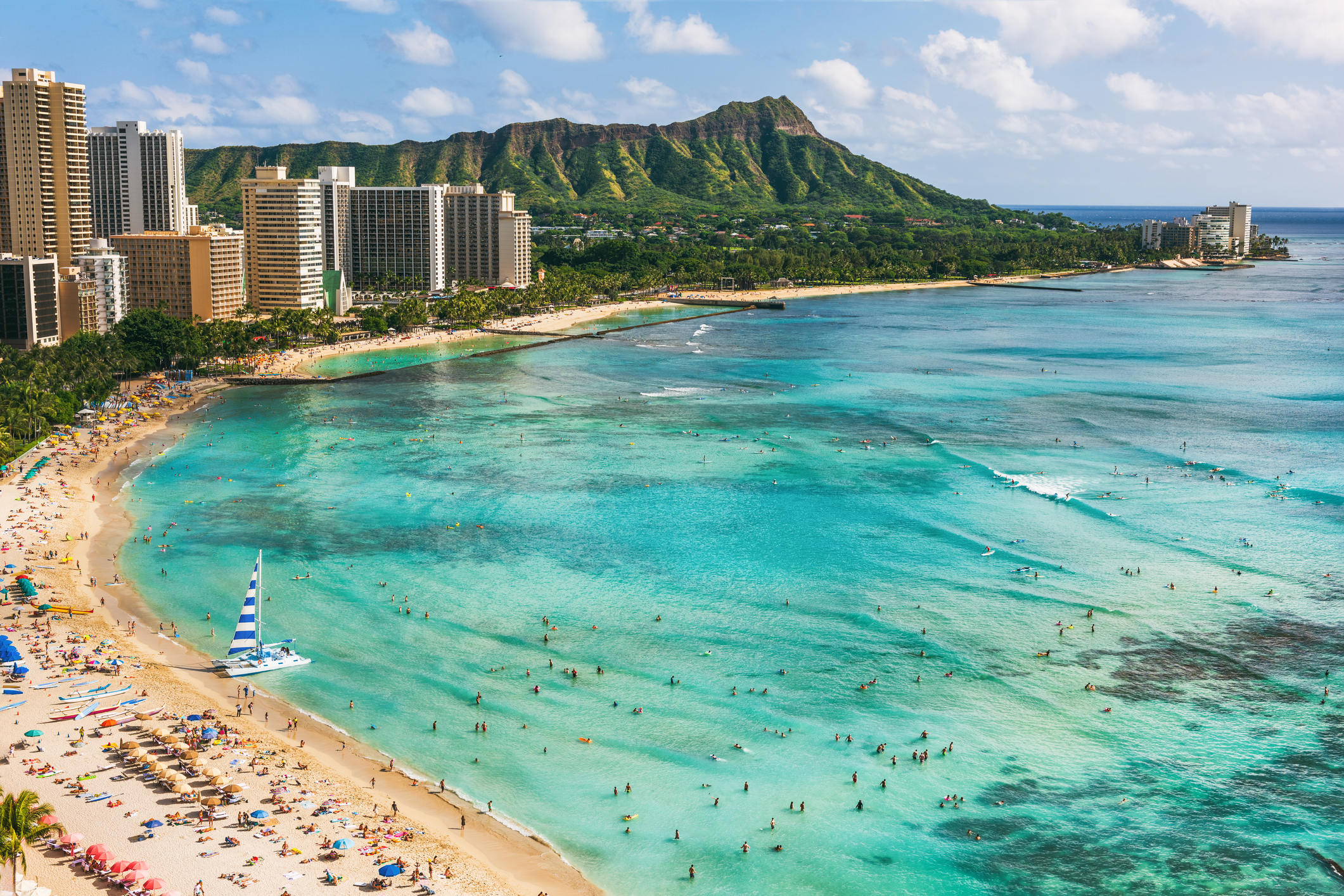Hawaii Approves First-of-its-Kind 'Green Fee' for Tourists: What to Know
Your trip to the Aloha State could be a bit more expensive next year. Here's why


If you’re planning a Hawaii vacation soon, expect a new tax coming your way.
That's because Hawaii just became the first state to impose a so-called "Green Fee" or "green tax" for tourists.
The fee, designed to help protect Hawai'i's natural ecosystem from the impacts of climate change, will raise the state’s transient accommodations tax (TAT) for nightly lodging. It will apply to hotel stays, cruise ship cabins, and short-term rentals.
From just $107.88 $24.99 for Kiplinger Personal Finance
Become a smarter, better informed investor. Subscribe from just $107.88 $24.99, plus get up to 4 Special Issues

Sign up for Kiplinger’s Free Newsletters
Profit and prosper with the best of expert advice on investing, taxes, retirement, personal finance and more - straight to your e-mail.
Profit and prosper with the best of expert advice - straight to your e-mail.
Since the Aloha State welcomes roughly 10 million visitors yearly, state officials say the fee could raise around $100 million annually.
A portion of the revenue from the climate impact fee will be directed toward Hawaii’s response to future disasters, like the Maui wildfire of 2023.
“Hawaii is at the forefront of protecting our natural resources, recognizing their fundamental role in sustaining the ecological, cultural, and economic health of Hawaiʻi,” said Gov. Josh Green in a press statement.
So, how much will the so-called "Green Fee" add to your stay in Hawaii?
Here's what you need to know, along with some other taxes you can expect when booking a trip.
Hawaii approves 'green tax' for tourists
Hawaii’s new climate impact fee will go into effect next year, in 2026. As mentioned, the fee is designed to mitigate climate change impacts by addressing wildfire risks and protecting vulnerable environments.
Gov. Green, who signed Act 96 into law, says the fee will translate to visitors paying an additional $3 per night on a $400 room stay.
“The fee will restore and remediate our beaches and shorelines and harden infrastructure critical to the health and safety of all who call Hawaii home, whether for a few days or a lifetime,” Green said in a statement.
If you’re planning to travel to Hawaii, here are some added fees you can expect for your nightly stay at a hotel and short-term rentals.
Note: Cruise ships that port in the state will also face TAT taxes for the first time.
- The tax that travelers pay for their hotel or vacation rental rooms — called the Transient Accommodation Tax (TAT) — is set to go up in Hawaii. Right now, it’s 10.25%, but next year it will be 11%. In 2027, it’s expected to rise again to 12%.
- Hawaii’s four counties can add an extra tax on top of the state TAT. All of them have decided to add the maximum possible, which is another 3%. When you add that to the new state TAT, you could end up paying a total tax of 14% for your accommodations.
- The General Excise Tax (GET) is also part of the bill, added to your room rate. That changes depending on which island you’re on, ranging from 4% to 4.5%.
Hawaii ‘green fee’ to raise $100 million a year

Hawaii's new "green tax" will apply to cruise ships that visit the island in 2026. Currently, cruises are exempt from the state’s transient accommodation tax, which is 10.25%.
The climate impact fee is expected to usher in $100 million annually. Gov. Green's administration will work with the state legislature to select projects and determine which local groups will benefit.
According to the governor's office, some key projects will likely include environmental stewardship, climate and hazard resiliency, and sustainable tourism.
Meanwhile, some groups and local reporters are concerned that part of the ‘green fee’ revenue could go to the state’s general fund.
- Originally, the governor’s proposal directed climate fee revenue to two new special funds: the Climate Mitigation and Resiliency Special Fund and the Economic Development and Revitalization Special Fund.
- However, after negotiations with the state Senate Ways and Means Committee, the final bill removed those special funds and put the revenue into the general fund instead.
- The bill requires the governor to request an amount close to the extra TAT revenues in the executive or supplemental budget to use the funds for projects addressing climate change, environmental protection, or tourism impact mitigation.
Why does this matter? Sometimes, when new taxes or fees are placed into the general fund, there is a risk that the money may be allocated to other shifting state priorities or unrelated projects, rather than the intended goals.
That uncertainty has led to questions about whether the climate fee will truly support the environmental and climate-related objectives it is designed to address.
Why Hawaii’s climate fee is a historic win
Though general tourist taxes aren't new, Hawaii is the first U.S. state to create a tax to address the rapid impact of climate change and mitigate the impact tourism can have on the environment.
The legislature found that the Aloha State is experiencing a climate emergency, with effects of climate change already impacting its residents and natural ecosystems. Some events have included rising temperatures, prolonged droughts, and destructive weather events that have impacted the islands.
Lawmakers also found that economic development couldn't be separated from environmental stewardship, as most of Hawaii’s economy is dependent on its natural resources.
The measure comes two years after a deadly wildfire engulfed some areas of the island of Maui and destroyed more than 2,200 structures in its wake. The U.S. Fire Administration reported that the natural disaster resulted in about $5.5 billion in damages. In Lahaina, more than 100 lives were lost.
Taking action now, through enacting a ‘green fee,’ could be a proactive step to safeguard the environment, residents, and businesses of the islands. Though Hawaii is the first state to usher in a tax of this kind, and the benefits remain to be seen, perhaps more states will follow.
Related Content
Profit and prosper with the best of Kiplinger's advice on investing, taxes, retirement, personal finance and much more. Delivered daily. Enter your email in the box and click Sign Me Up.

Gabriella Cruz-Martínez is a finance journalist with 8 years of experience covering consumer debt, economic policy, and tax.
Gabriella’s work has also appeared in Yahoo Finance, Money Magazine, The Hyde Park Herald, and the Journal Gazette & Times-Courier.
As a reporter and journalist, she enjoys writing stories that empower people from diverse backgrounds about their finances, no matter their stage in life.
-
 3 Ways to Stretch the 2026 Social Security COLA For Your Budget
3 Ways to Stretch the 2026 Social Security COLA For Your BudgetThree steps retirees can take to stretch the Social Security COLA to fit their budgets.
-
 How to Keep Your Charitable Giving Momentum Going All Year
How to Keep Your Charitable Giving Momentum Going All YearInstead of treating charity like a year-end rush for tax breaks, consider using smart tools like DAFs and recurring grants for maximum impact all the year.
-
 Uber Takes Aim at the Bottom Lines of Billboard Lawyers
Uber Takes Aim at the Bottom Lines of Billboard LawyersUber has filed lawsuits and proposed a ballot initiative, in California, to curb settlements it claims are falsely inflated by some personal injury lawyers.
-
 New 2026 Tax Change Could Mean More for Your IRA and 401(k) Savings
New 2026 Tax Change Could Mean More for Your IRA and 401(k) SavingsRetirement Savings Here's how the new IRS inflation adjustments will increase the contribution limits for your 401(k) and IRA in the new year.
-
 Capital Gains Tax Quiz: How Well Do You Really Know IRS Investment Tax Rules?
Capital Gains Tax Quiz: How Well Do You Really Know IRS Investment Tax Rules?Quiz Take our capital gains tax quiz to test your investment taxes knowledge. Learn about loss rules, holding periods, and tax incentives that could impact your savings.
-
 6 Tax Reasons to Convert Your IRA to a Roth (and When You Shouldn't)
6 Tax Reasons to Convert Your IRA to a Roth (and When You Shouldn't)Retirement Taxes Here’s how converting your traditional retirement account to a Roth IRA can boost your nest egg — but avoid these costly scenarios.
-
 3 Ways High-Income Earners Can Maximize Their Charitable Donations in 2025
3 Ways High-Income Earners Can Maximize Their Charitable Donations in 2025Tax Deductions New charitable giving tax rules will soon lower your deduction for donations to charity — here’s what you should do now.
-
 Another State Bans Capital Gains Taxes: Will More Follow in 2026?
Another State Bans Capital Gains Taxes: Will More Follow in 2026?Capital Gains A constitutional amendment blocking future taxes on realized and unrealized capital could raise interesting questions for other states.
-
 Emergency Tax Bill Ends $6,000 Senior Deduction and Tip, Overtime Tax Breaks in D.C.
Emergency Tax Bill Ends $6,000 Senior Deduction and Tip, Overtime Tax Breaks in D.C.Tax Law Here’s how state tax conformity rules could immediately raise your income tax liability.
-
 New RMD Rules: Can You Pass This Retirement Distributions Tax Quiz?
New RMD Rules: Can You Pass This Retirement Distributions Tax Quiz?Quiz Take our RMD quiz to test your retirement tax knowledge. Learn about RMD rules, IRS deadlines, and tax penalties that could shrink your savings.
-
 10 Retirement Tax Plan Moves to Make Before December 31
10 Retirement Tax Plan Moves to Make Before December 31Retirement Taxes Proactively reviewing your health coverage, RMDs and IRAs can lower retirement taxes in 2025 and 2026. Here’s how.